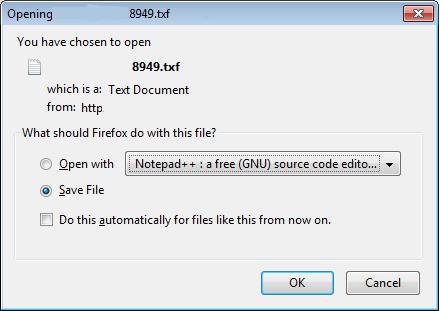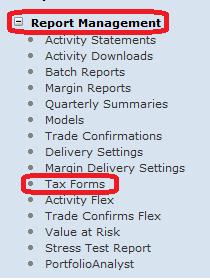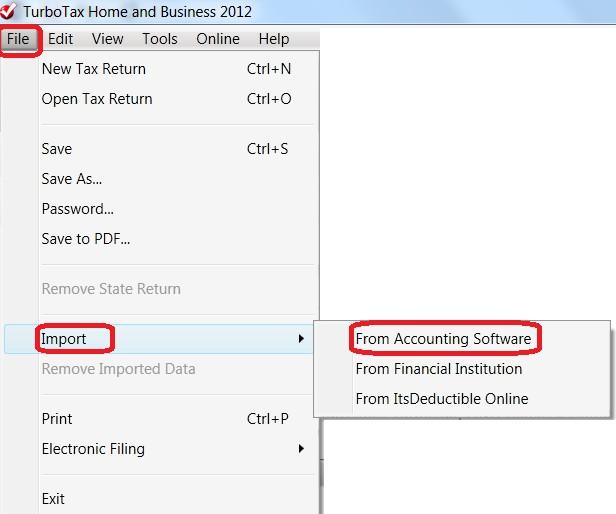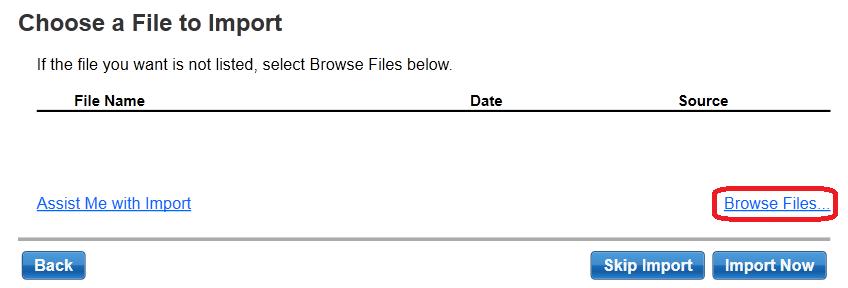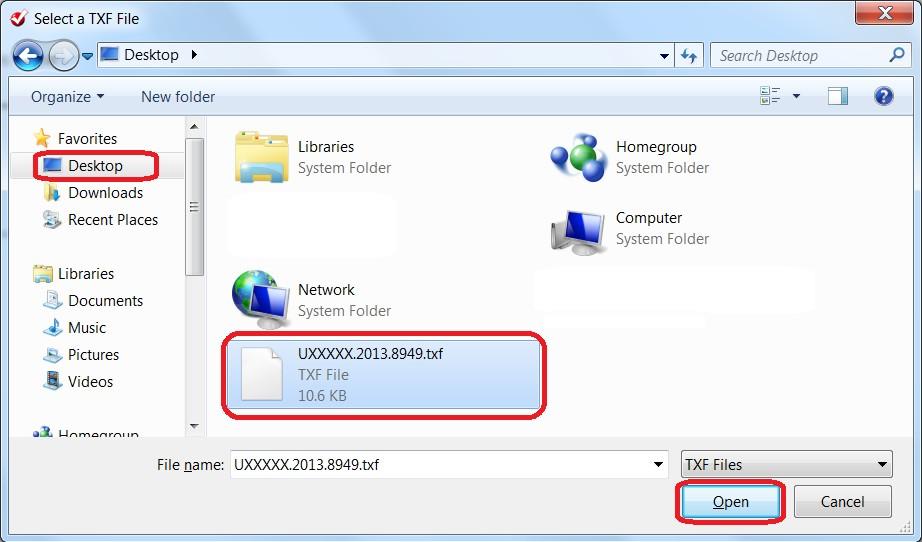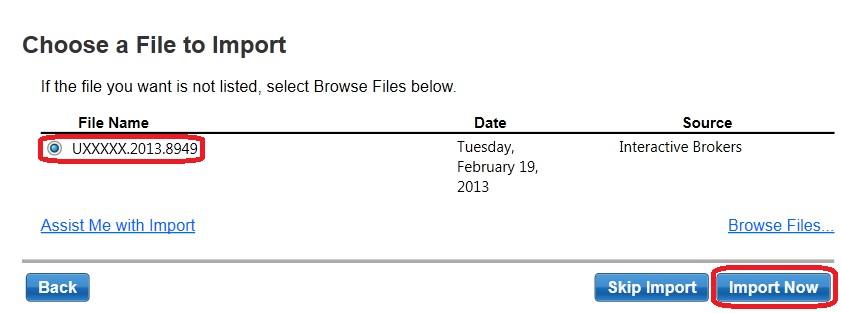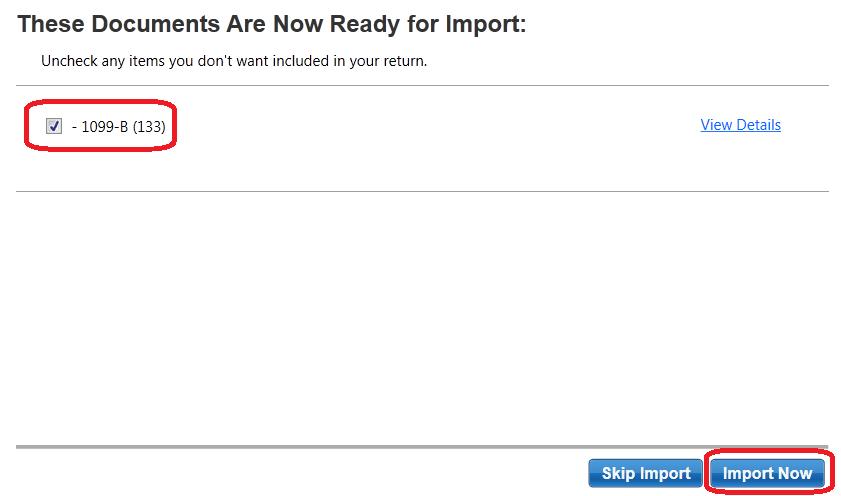Steps for Importing Worksheet for Form 8949 to TurboTax
As a matter of operational convenience and to assist with the preparation of IRS Form 8949 (Sales and Other Dispositions of Capital Assets) IB Prepares a Form 8949 worksheet in each of a PDF, CSV and TXF format on an annual basis. The TXF format allows you to import the information into Turbo Tax Standalone(CD/Download Version) but not the online version. Please click here for to visit our Turbo Tax FAQ's.
How to Import Form 8949 into TurboTax
1. Log into Account Management by going to https://www.interactivebrokers.com and select Login and then Account Management from the upper right hand section and enter username/password to log in.
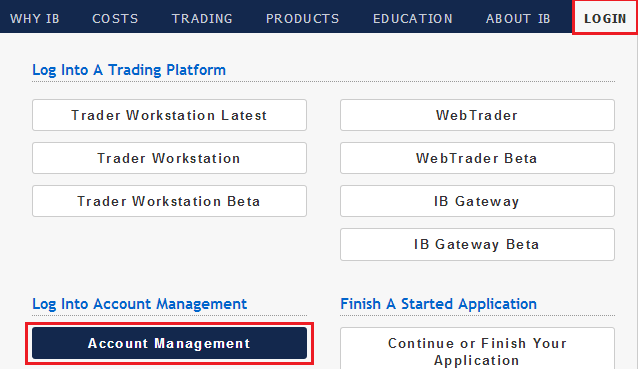
2. Navigate to Reports, Tax and then select Tax Forms
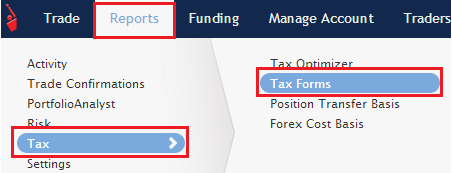
3. Under Worksheet for Form 8949 section, select TurboTax TXF from the drop down menu and select View Report

4. A save dialog box will appear. Please select Save File and then OK.
5. Another dialog box will appear. Please select Desktop on the left and then Save. This will save your downloaded file to your desktop
6. Now that the file is downloaded please follow the directions below in Section C to import into TurboTax
Section B (Vertical menu on the left)
1. Log into Account Management by going to www.interactivebrokers.com and select Login and then Account Management from the upper right hand section and enter username/password to log in.
.jpg)
2. On the left please select Report Management and then Tax Forms
3. On the right under Worksheet for Form 8949 section, select TurboTax TXF from the drop down menu and select View Report
4. A save dialog box will appear. Please select Save File and then OK
5. Another dialog box will appear. Please select Desktop on the left and then Save. This will save your download file to your desktop
6. Now that the file is downloaded please follow the directions below in Section C to import TurboTax
Section C (Importing downloaded file into TurboTax)
1. Open TurboTax and navigate to File and select “From Accounting Software” under the Import option.
2. A new window will appear with a few options. Please select Other Financial Software (TXF file) and then Continue
3. On the next screen select Browse Files
4. A new window will appear. Please select Desktop on the left and then select the file you just saved on your desktop and then select Open.
5. A new window will appear with the name of the file. Select Import Now
6. On the next page you will see 1099-B (133). Make sure the box next to it is checked and then select Import Now
7. On the last page select Done and all your transactions will now be imported into TurboTax. If you need any additional help navigating TurboTax please contact them directly at http://turbotax.intuit.com/
Form 8949 Worksheet – TurboTax Import Considerations
In order to complete the Form 8948 in an IRS compliant manner, adjustments to the gain or loss of a particular transaction may be required in order to reconcile the totals on this form with the corresponding fields on Form 1099-B. When an adjustment is required, entry of a IRS specific code is also required in order to explain the adjustment. Example of codes are as follows:
W: The customer has a nondeductible loss from a wash sale. This applies where the transaction being reported is a wash sale
B: The basis reported on box 3 of Form 1099-B requires clarification. Take, for example, a wash sale where the original security was purchased prior to January 1, 2011 (i.e., classified as "non-covered"), sold at a loss and the replacement purchased within 30 days but after January 1, 2011 (i.e., classified as "covered"). In this case, the basis reported on Form 1099-B for the "covered security" does not include the disallowed loss from the wash sale and an adjustment on the 8949 worksheet is required.
T: The type of gain or loss (short-term or long-term) shown in box 1c of Form 1099-B requires clarification. Take, for example, a wash sale not reported on the Form 1099-B because the original purchase involved a "non-covered" security and where the replacement security is later sold. The holding period for the original purchase must be included in that of the later transaction and any adjustment from short- to long-term reflected on the 8949 worksheet.
E: The transaction is reported on Form 1099-B and there are selling expenses or option premiums that are not reflected on the form or statement to either the proceeds or basis shown. (this applies to options purchased or sold prior to 2011.)
O: There is an adjustment that we have failed to identify.
Currently, TurboTax only supports adjustments associated with code “W” and transactions which are subject to an adjustment requiring a different code cannot be imported to TurboTax through the TXF file.
If your worksheet contains unsupported codes, you will be notified of this through an error message provided when attempting to download the TXF file through Account Management (i.e., “Your import file contains IRS required information, the import of which is not supported by TurboTax”). If this is the case, TurboTax offers an alternative method which allows one to enter summary numbers from the worksheets into the electronic version of Form 8949, file electronically and mail in a schedules of trades thereafter. Detailed instructions for this method are outlined below.
STEPS FOR ENTERING 8949 WORKSHEET SUMMARIES INTO TURBOTAX
TurboTax software download does not support all of the possible adjustment codes on Form 8949 – Sales and Other Dispositions of Capital Assets. Please follow the following instruction to add your securities transactions to your Turbo Tax prepared return.
Step 1: Print your Form 8949 Worksheet from Account Management through the Reports and then Tax Forms menu options. Please review the worksheet for any errors or omissions and verify that it is correct.
Step 2: In TurboTax, open your return and select Personal and then select Personal Income menu options.
Step 3: Scroll down until you reach the Investment Income Section and select
Stock, Mutual Funds, Bonds, Other and go to Start.
Step 4: Select EasyGuide
Step 5: Scroll down to the Other section and select from the following:
For Form 8949 worksheet Parts 1 and 2 Box A: Attach a statement – Broker-reported sales with basis reported to IRS
For Form 8949 worksheet Parts 1 and 2 Box B: Attach a statement – Broker – reported sales – no cost reported to IRS
For Form 8949 worksheet Parts 1 and 2 Box C: Attach a statement –
Sales without a broker statement
Note: Transactions reported on Form 8949 worksheet by IB include option transactions which as of the 2012 tax year are not required to be reported by brokers to the IRS on Form 1099-B.
Step 6: Select Short- or Long-Term as follows:
For Form 8949 worksheet Part 1 Box A : Short–Term
For Form 8949 worksheet Part 1 Box B: Short–Term
For Form 8949 worksheet Part 1 Box C : Short–Term
For Form 8949 worksheet Part 1 Box A: Long-Term
For Form 8949 worksheet Part 2 Box B: Long-Term
For Form 8949 worksheet Part 3 Box C: Long-Term
Select Continue
Step 7: On the new window, change the Date Sold box to Various and enter the totals from the part of the Form 8949 worksheet you are working from in the net proceeds box and codes.
Step 8: Check the box titled “My statement includes adjustment codes as described in Form 8949 instructions".
Step 9: Enter the adjustment column total from the Form 8949 worksheet you are working from and adjustment code M
Select Continue, verify results and, if correct, then Continue.
To add another set of worksheet totals begin again at step 5. If your Form 8949
Worksheet has information in all six sections you will need to repeat this process 5 additional times.
When this is complete, select Done and if you have completed this section, done with investment sales.
Upon e-filing your return a Form 8453 will be created. This form must be printed an mailed to the IRS along with copies of your Form 8949 worksheets within 3 business days after you have received acknowledgment from TurboTax that the IRS has accepted your electronically filed tax return.
Foreign Acount Tax Compliance Act (FATCA)
What is FATCA?
The Foreign Account Tax Compliance Act (FATCA) represents the United States efforts to combat tax evasion and abuse by US persons holding investments outside of the United States. The Act establishes a new set of tax information reporting and withholding procedures. While not expressly aimed at non-US persons, the regulations do impose withholding taxes on certain non-US entities that decline to disclose their US investors or account holders.
Under FATCA, US persons must report to the US tax authority, Internal Revenue Service (IRS), their assets held in offshore accounts. In addition, the regulations seek to require non-US financial institutions to report to the US tax authority certain information about financial accounts of US or US-owned investors and account holders.
How does this impact US Brokers, including Interactive Brokers?
As a broker based in the United States, Interactive Brokers is required to report information and make payment of withholding taxes to the IRS, for all of our customers. FATCA simply creates additional practices and withholdings to the current requirements for all US brokers.
Interactive Brokers will comply with the new rules. This may require additional disclosures by investors during the account application process, as well as expanded tax reporting. For all US institutions, FATCA becomes effective January 1, 2013. Any FATCA tax withholding requirements begin on January 1, 2014.
Additional aspects of the regulations will be phased-in over the next few years, including an expansion of US brokers reporting on US source income to non-US accounts through Form 1042-S.
What action is required for US persons?
No additional action is required for US persons holding Interactive Brokers accounts. US persons, who include US citizens, Green Card holders and other legal residents, need only to complete Form W-9 during the account application process to certify their tax status.
Does FATCA affect non-US accounts?
Yes. FATCA requires foreign financial institutions (FFIs) to furnish certain data directly to the IRS about any of their US taxpayer accounts or foreign entity accounts in which US taxpayers hold a certain level of ownership. FFI compliance with the new regulations becomes effective July 1, 2013 with the submission of electronic FFI applications to the IRS. The application forms are scheduled to be available through the IRS in January 2013.
All non-US persons and entities applying for and maintaining Interactive Broker accounts will continue to be required to fully disclose and indentify the identity of their account's beneficial owner(s). Through the IRS Form W-8, our account holders certify the beneficial owner's country of tax residence. If you fail to provide a Form W-8, or do not resubmit a new W-8 when prompted upon the three-year expiration, additional withholding will apply.
Some entities not ordinarily considered to be financial institutions may be categorized under FATCA as an FFI. Therefore, it is important to review the details outlined by the IRS.
Is there a summary of FFI requirements?
While the regulations and compliance are far more complex than a brief FAQ can describe, the following offers a short summary of actions required by those defined foreign financial institutions.
- Identify US taxpayers. If US taxpayers refuse to waive your non-US country's privacy or secrecy rules, then the US taxpayer account must be closed.
- Report to the IRS on the related US taxpayer activity within defined financial accounts.
- Withhold 30% US tax on US source income against any US taxpayer or foreign entity failing to disclose information or comply with the FATCA regulations.
Additional Information & Resources
The IRS remains the most comprehensive and up-to-date resource about FATCA compliance, implementation, and document filing. The IRS continues to issue news releases and forms. Please feel free to visit the IRS FATCA Website for details.
IRS Circular 230 Notice: These statements are provided for information purposes only, are not intended to constitute tax advice which may be relied upon to avoid penalties under any federal, state, local or other tax statutes or regulations, and do not resolve any tax issues in your favor.
Tax Reporting: About Forms 1099
Forms 1099 are a series of U.S. tax information returns which report income earned as interest, dividends, proceeds from securities and commodities sale transactions, and other reportable payments posted to your account during a calendar year. These reports, which are supplied to the IRS, provide information, which should be used in preparing your tax return. For example, dividends and interest, are reported on IRS Form 1040, "U.S. Individual Income Tax Return", Schedule B. Sales transactions are to be reported on IRS Form 1040, "U.S. Individual Income Tax Return", Schedule D.
Information on reporting gains and losses, including determining the cost basis, can be obtained by reading IRS Publications 544, "Sales and Other Dispositions of Assets", and 551, "Basis of Assets." We recommend you consult your tax professional with specific questions.
All of the IRS forms and publications referenced above are available online at www.IRS.gov/formspubs
In compliance with Treasury Department Circular 230, unless stated to the contrary, any information contained in this FAQ was not intended or written to be used and cannot be used for the purpose of avoiding tax penalties that may be imposed on any taxpayer.
Tax: UK Persons and Entities: W-8 Forms for Non-US Residents
You must complete a Form W-8 because the entity holding your client money is Interactive Brokers LLC, in the US.
In compliance with Treasury Department Circular 230, unless stated to the contrary, any information contained in this FAQ was not intended or written to be used and cannot be used for the purpose of avoiding tax penalties that may be imposed on any taxpayer.
Tax: Canadian Persons and Entities: Form T5008
Canadian Slip T5008, Statement of Securities Transactions, contains proceeds and cost information, but capital gains/losses are not reported.
In compliance with Treasury Department Circular 230, unless stated to the contrary, any information contained in this FAQ was not intended or written to be used and cannot be used for the purpose of avoiding tax penalties that may be imposed on any taxpayer.
Tax: Canadian Persons and Entities: Tax Form Availability
T5008 and T5 forms are available on February 28th.
The T3 forms are generally available on March 31st. Some T3s may be made available after this date if the information is received late. You should always try to match the available T3s with the distributions received as shown on your dividend report or account statements.
NR4s will be available March 31st.
In compliance with Treasury Department Circular 230, unless stated to the contrary, any information contained in this FAQ was not intended or written to be used and cannot be used for the purpose of avoiding tax penalties that may be imposed on any taxpayer.
Tax Reporting: Unrealized Capital Gains Distributions from Regulated Investment Companies (RICs) and Real Estate Investment Trusts (REITs)
These gains are reported on Form 2439 in Box 1a. There may be tax paid on your behalf by the RIC or REIT; this tax is reported to you on Form 2439 in Box 2.
In compliance with Treasury Department Circular 230, unless stated to the contrary, any information contained in this FAQ was not intended or written to be used and cannot be used for the purpose of avoiding tax penalties that may be imposed on any taxpayer.
Tax Reporting: Understanding Qualified Dividends
Qualified Dividends are distributions which meet the criteria to be subject to a beneficial federal tax rate. In general, qualified dividends are distributions received from U.S. Domestic corporations or qualified foreign corporations where you have owned the investment for more than 61 days before or after the ex dividend date. IRS Publication 550 “Investment Income and Expenses” available free on line at www.IRS.gov and/or your tax professional can assist in determining if your dividends are eligible for the beneficial rate.
In compliance with Treasury Department Circular 230, unless stated to the contrary, any information contained in this FAQ was not intended or written to be used and cannot be used for the purpose of avoiding tax penalties that may be imposed on any taxpayer.

